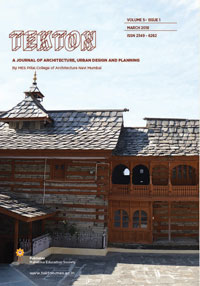Nancy Adajania
Tekton
Volume 5, Issue 1, March 2018
pp. 74 – 81
 Nancy Adajania is a cultural theorist and curator based in Bombay. Since the late 1990s, she has written consistently on the practices of four generations of Indian women artists. Her book, The Thirteenth Place: Positionality as Critique in the Art of Navjot Altaf (The Guild Art Gallery, 2016), goes beyond the mandate of a conventional artist monograph to map the larger histories of the Leftist and feminist movements in India. Adajania was Joint Artistic Director of the 9th Gwangju Biennale (2012). In 2013 and 2014, she taught the curatorial practice course at the Salzburg International Summer Academy of Fine Arts. She edited the transdisciplinary anthology ‘Some things that only art can do’ (Raza Foundation, 2017) and is currently working on another anthology ‘Totems and Taboos: What can and cannot be done’.
Nancy Adajania is a cultural theorist and curator based in Bombay. Since the late 1990s, she has written consistently on the practices of four generations of Indian women artists. Her book, The Thirteenth Place: Positionality as Critique in the Art of Navjot Altaf (The Guild Art Gallery, 2016), goes beyond the mandate of a conventional artist monograph to map the larger histories of the Leftist and feminist movements in India. Adajania was Joint Artistic Director of the 9th Gwangju Biennale (2012). In 2013 and 2014, she taught the curatorial practice course at the Salzburg International Summer Academy of Fine Arts. She edited the transdisciplinary anthology ‘Some things that only art can do’ (Raza Foundation, 2017) and is currently working on another anthology ‘Totems and Taboos: What can and cannot be done’.
nancyadajania@gmail.com
ABSTRACT
This review-commentary analyses and annotates two path breaking publications authored by Madhavi Desai and Mary Woods. The authors have retrieved and contextualised the practices of Indian women architects who have long remained invisible in the architectural canon dominated by the patriarchs of modernism. The received wisdom is that the male architect, usually in lonely Roarkian splendour, has a great macrocosmic vision. In truth, women architects have been driven by great visions too as designers, policy makers, pedagogues, conservationists and activists, but their visions have not been codified in readily recognisable formulae. Theirs is not the Ozymandian obsession with the singular building; rather, it is a continuing and often mutating, shape-shifting engagement with people, labour and ecology.
KEY WORDS
Women Architects, Indian Modernism, Feminism, Desai, Woods


